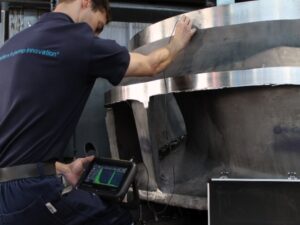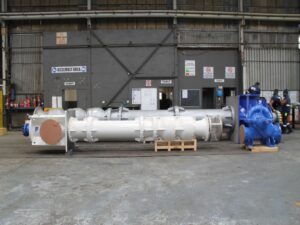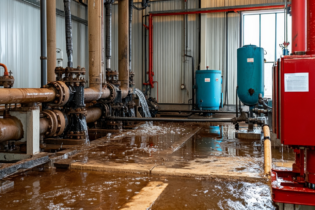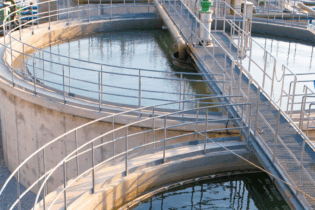Proudly South African original equipment manufacturer (OEM)–the APE Pumps and Mather+PlattGroup –uses technology and its expertise to extend every pump’s life, repairing components where practical. WASA catches up with the team about some of their recent equipment acquisitions and their commitment to quality control.
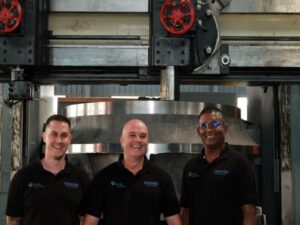 Retrofitting pumps for water systems can lead to significant energy savings, improved performances, extended lifespans, and enhanced functionality with advanced monitoring and control features. But what happens if there are no technical drawings of the pump, or a pump model has been discontinued or the pump manufacturer no longer exists or has exited the country?
Firstly, if it’s an APE Pump, it is reassuring to know that technical drawings for every single pump ever produced since 1952 is in a vault system. These technical drawings can be used to execute assessments, repairs, refurbishments or a complete rebuild. The drawings contain details like metallurgical materials, type of liquid handled, casing and impeller trims.
“Our record keeping is a vital service for our public and private sector end-users, some of whom may no longer have any institutional knowledge of our pumps due to organisational and/or ownership changes. We also keep records of legacy products we inherited as a Group prior to our formation in 1952,” explains John Montgomery, general manager for group companies – APE Pumps and Mather+Platt.
This contrasts with large parts of Asia, Europe and the USA, where many pumps are considered obsolete after five years of service. “This is not at all common in South Africa or the rest of Africa for that matter. There are countless pumps that have been in operation on this continent for decades and decades. All they need is a new part or a retrofit in order to operate for another couple of decades,” says Neil Richards, a sales engineer at APE Pumps.
3D scanning
In these circumstances, for all other non-APE pumps, a 3D scanner is used to produce a complete model of pump parts in minutes, taking geometric accuracy and on-site lidar surveys to an unprecedented level.
“With this data, we then reengineer and manufacture the pump parts in our pattern shop. The 3D scanner has drastically increased our turn-around time for pump repairs and retrofits,” says Richards.
He adds that it is important to remember that a pump works within a system. Often, if a new pump is installed, the piping around the pump as well as the plinths and motors usually need to be replaced too, which is costly, time consuming and can cause a pro-longed shutdown of operations. In these instances, 3D scanning can be used to take dimensions of the pump that must be replaced, and then manufacture a new pump to fit into the manifolds.
If it is a complete rebuild, the manufacturing team can scan the original, make a pattern, manufacture it, scan the new one, and then compare the two in a digital overlay for verification.
Last year, the company scanned an entire pump station, where the model of the pump that was to be installed was attached to the 3D scanner. This put the pump in a virtual world and allowed APE to make sure the flanges were matching and fit perfectly into the casing. The scanner also helped to plan how the pump would be installed. This is valued by clients who do not have up-to-date plans of their pump stations.
According to Thorne Zurfluh, a mechanical engineer at APE Pumps, one of the biggest benefits of 3D scanning is quality control. “At APE, 3D scanning is used over and above the traditional quality control methods. It is an additional aid to prevent the misalignment of pumps by verifying pump geometries (concentricity, parallelism, perpendicularity and shaft runouts) during manufacturing, assembly and even commissioning. All pump parts are scanned to confirm that they meet the specifications of the manufacturing drawings. The 3D scans also generate digital reports indicating that the pump and pump parts meet (or do not meet) certain specifications and tolerances. These reports are often supplied to customers.”
Retrofitting pumps for water systems can lead to significant energy savings, improved performances, extended lifespans, and enhanced functionality with advanced monitoring and control features. But what happens if there are no technical drawings of the pump, or a pump model has been discontinued or the pump manufacturer no longer exists or has exited the country?
Firstly, if it’s an APE Pump, it is reassuring to know that technical drawings for every single pump ever produced since 1952 is in a vault system. These technical drawings can be used to execute assessments, repairs, refurbishments or a complete rebuild. The drawings contain details like metallurgical materials, type of liquid handled, casing and impeller trims.
“Our record keeping is a vital service for our public and private sector end-users, some of whom may no longer have any institutional knowledge of our pumps due to organisational and/or ownership changes. We also keep records of legacy products we inherited as a Group prior to our formation in 1952,” explains John Montgomery, general manager for group companies – APE Pumps and Mather+Platt.
This contrasts with large parts of Asia, Europe and the USA, where many pumps are considered obsolete after five years of service. “This is not at all common in South Africa or the rest of Africa for that matter. There are countless pumps that have been in operation on this continent for decades and decades. All they need is a new part or a retrofit in order to operate for another couple of decades,” says Neil Richards, a sales engineer at APE Pumps.
3D scanning
In these circumstances, for all other non-APE pumps, a 3D scanner is used to produce a complete model of pump parts in minutes, taking geometric accuracy and on-site lidar surveys to an unprecedented level.
“With this data, we then reengineer and manufacture the pump parts in our pattern shop. The 3D scanner has drastically increased our turn-around time for pump repairs and retrofits,” says Richards.
He adds that it is important to remember that a pump works within a system. Often, if a new pump is installed, the piping around the pump as well as the plinths and motors usually need to be replaced too, which is costly, time consuming and can cause a pro-longed shutdown of operations. In these instances, 3D scanning can be used to take dimensions of the pump that must be replaced, and then manufacture a new pump to fit into the manifolds.
If it is a complete rebuild, the manufacturing team can scan the original, make a pattern, manufacture it, scan the new one, and then compare the two in a digital overlay for verification.
Last year, the company scanned an entire pump station, where the model of the pump that was to be installed was attached to the 3D scanner. This put the pump in a virtual world and allowed APE to make sure the flanges were matching and fit perfectly into the casing. The scanner also helped to plan how the pump would be installed. This is valued by clients who do not have up-to-date plans of their pump stations.
According to Thorne Zurfluh, a mechanical engineer at APE Pumps, one of the biggest benefits of 3D scanning is quality control. “At APE, 3D scanning is used over and above the traditional quality control methods. It is an additional aid to prevent the misalignment of pumps by verifying pump geometries (concentricity, parallelism, perpendicularity and shaft runouts) during manufacturing, assembly and even commissioning. All pump parts are scanned to confirm that they meet the specifications of the manufacturing drawings. The 3D scans also generate digital reports indicating that the pump and pump parts meet (or do not meet) certain specifications and tolerances. These reports are often supplied to customers.”
 Pattern making
Pattern makingDovetailing tried and tested techniques with modern technologies is a hallmark of APE Pumps and Mather+Platt’s success. Today, for example, the Group is one of the few OEMs that still has a pattern-making shop, headed by a master artisan.
Traditionally, 2D drawings were used – with the measurements painstakingly replicated by hand by the group’s patternmakers – to create the casting mould. Now, the 3D scanning method has produced more rapid results. “A pattern maker cannot be replaced by technology. For a pattern to be milled out of a block of wood, one needs a person that is a pattern maker, draughtsman and machinist. That pattern maker must understand a bunch of other complexities such as shrinkage rates of different materials. Only then can that person operate a computer numerical control (CNC) machine correctly,” states Montgomery.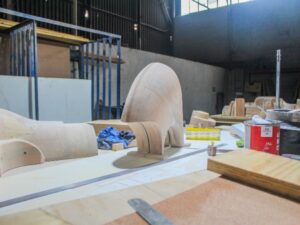 Non-destructive testing
Another technology adopted by APE Pumps is non-destructive testing (NDT) that detects the presence of defects or flaws in a pump part without damaging or destroying the material being examined.
“NDT give our clients total quality assurance. Examples of NDT processes include ultrasonic examination, magnetic particle inspection and dye pen testing. An ultrasonic examination uses soundwaves to identify cracks and a material’s thickness based on the rate of response. Magnetic particle inspections are used to check for surface or subsurface cracks in pumps made with ferrous metals. Another common NDT technique employed by the Group is dye penetrant inspection – used to detect any hairline cracks in the surfaces of pump parts. All three tests must be done by a qualified, trained professions,” explains Zurfluh.
According to Richards, NDT has been used on a lot of old pump shafts, as flaws are difficult to detect with the naked eye. “This is another preventative measure that we offer clients, as a broken shaft can cause a catastrophic pump failure.”
Remote monitoring
Some APE customers such as water boards have opted for remote monitoring. Systems can be set up for either APE or the client to monitor pump performances. “The need for remote monitoring is driven by the demand for improved energy efficiency, as well as enhanced maintainability and serviceability of pumps. Variable Speed Drives (VSDs) provide a much higher level of monitoring and protection,” says Zurfluh .
He adds that remote monitoring assists with predictive maintenance and further improves service levels. “Bearing temperatures, output, vibrations and energy consumption are a few of the parameters that can be monitored. This allows APE to identify any pump issues in advance, make sure the pump is operating on the right curve and conduct more proactive maintenance, instead of clients running pumps to failure. We are also seeing an increasing shift towards outsourced operations and maintenance, which is a key growth area for the group, working with clients to optimise their systems.”
Recently, the Group has made significant technological investments, these include:
Non-destructive testing
Another technology adopted by APE Pumps is non-destructive testing (NDT) that detects the presence of defects or flaws in a pump part without damaging or destroying the material being examined.
“NDT give our clients total quality assurance. Examples of NDT processes include ultrasonic examination, magnetic particle inspection and dye pen testing. An ultrasonic examination uses soundwaves to identify cracks and a material’s thickness based on the rate of response. Magnetic particle inspections are used to check for surface or subsurface cracks in pumps made with ferrous metals. Another common NDT technique employed by the Group is dye penetrant inspection – used to detect any hairline cracks in the surfaces of pump parts. All three tests must be done by a qualified, trained professions,” explains Zurfluh.
According to Richards, NDT has been used on a lot of old pump shafts, as flaws are difficult to detect with the naked eye. “This is another preventative measure that we offer clients, as a broken shaft can cause a catastrophic pump failure.”
Remote monitoring
Some APE customers such as water boards have opted for remote monitoring. Systems can be set up for either APE or the client to monitor pump performances. “The need for remote monitoring is driven by the demand for improved energy efficiency, as well as enhanced maintainability and serviceability of pumps. Variable Speed Drives (VSDs) provide a much higher level of monitoring and protection,” says Zurfluh .
He adds that remote monitoring assists with predictive maintenance and further improves service levels. “Bearing temperatures, output, vibrations and energy consumption are a few of the parameters that can be monitored. This allows APE to identify any pump issues in advance, make sure the pump is operating on the right curve and conduct more proactive maintenance, instead of clients running pumps to failure. We are also seeing an increasing shift towards outsourced operations and maintenance, which is a key growth area for the group, working with clients to optimise their systems.”
Recently, the Group has made significant technological investments, these include:
- A centre lathe equipped to handle jobs ranging in lengths of up to 8 m and in varying diameters for components such as columns, shafts, and impellers (specifically for circulating water pumps)
- A key slotter for keyway cutting (a drive system feature on one of the group’s impeller-lines to enable rotation around the shaft)
- A 12-ton CNC horizontal boring machine for the final machining of larger impellers, which typically measure around 3m in diameter
- A vertical boring machine for the machining of larger components with a Ø3500
